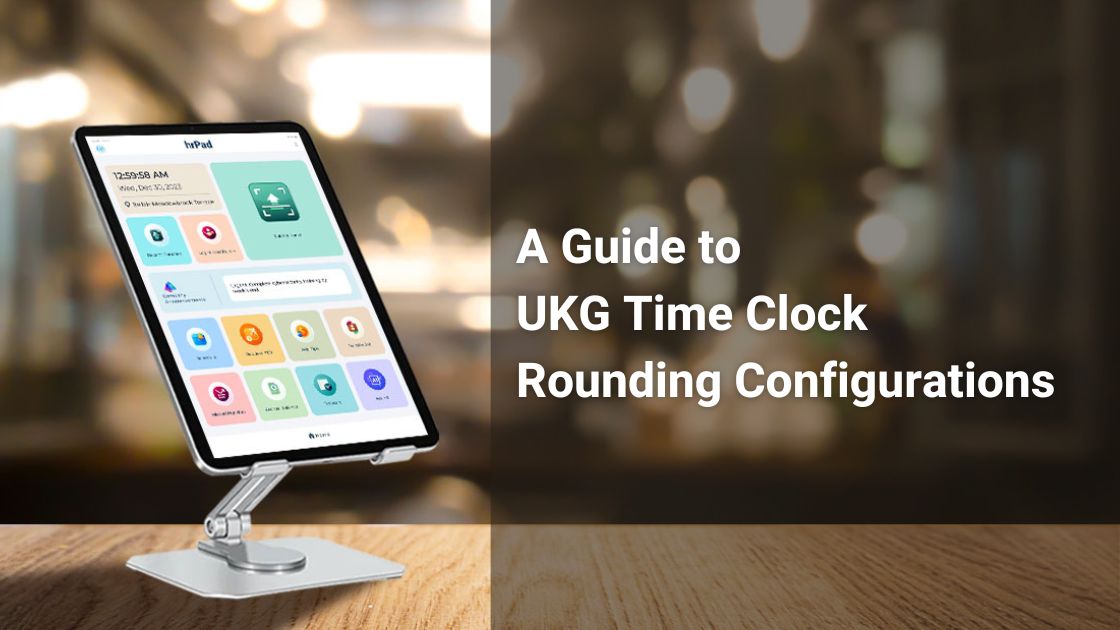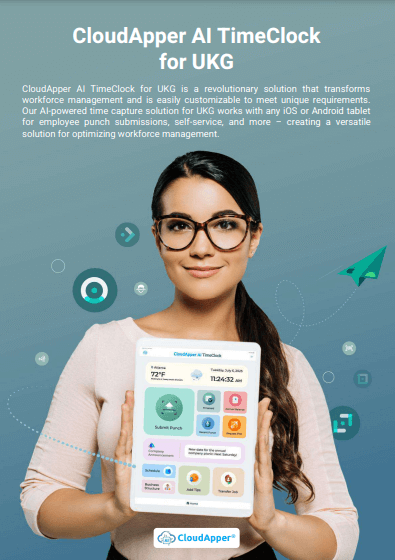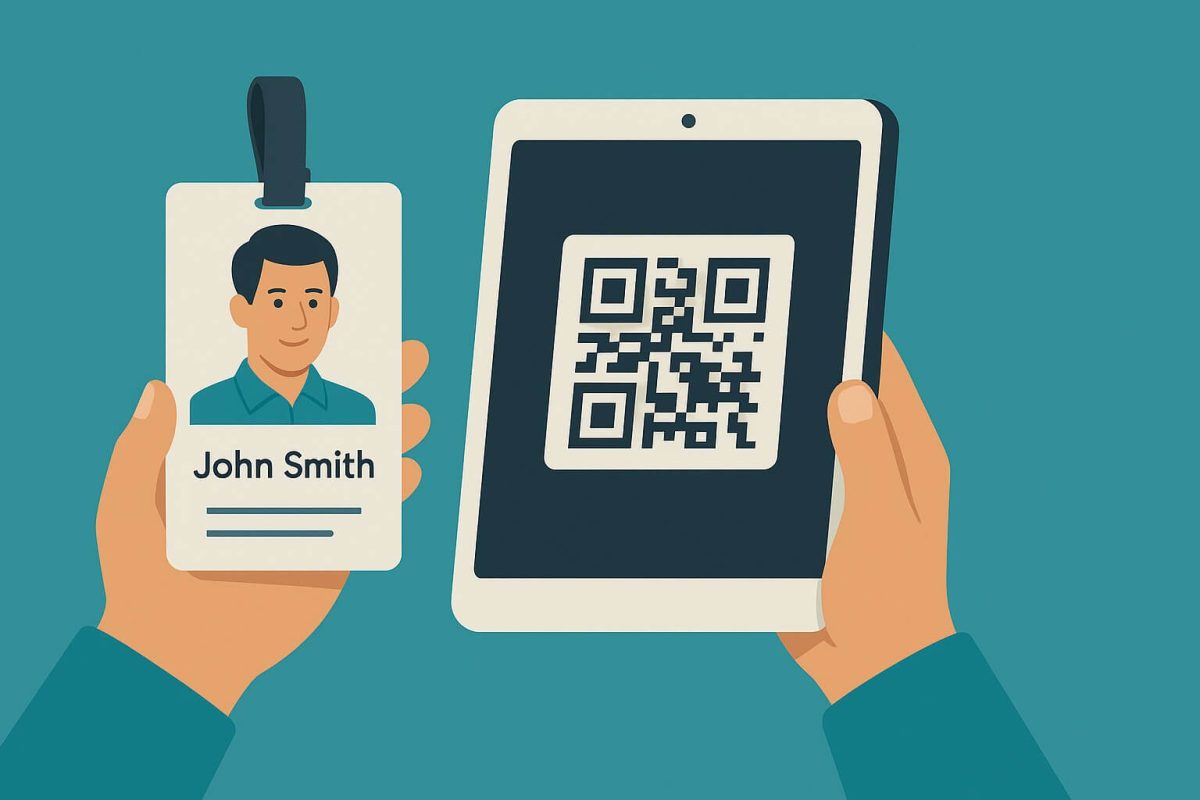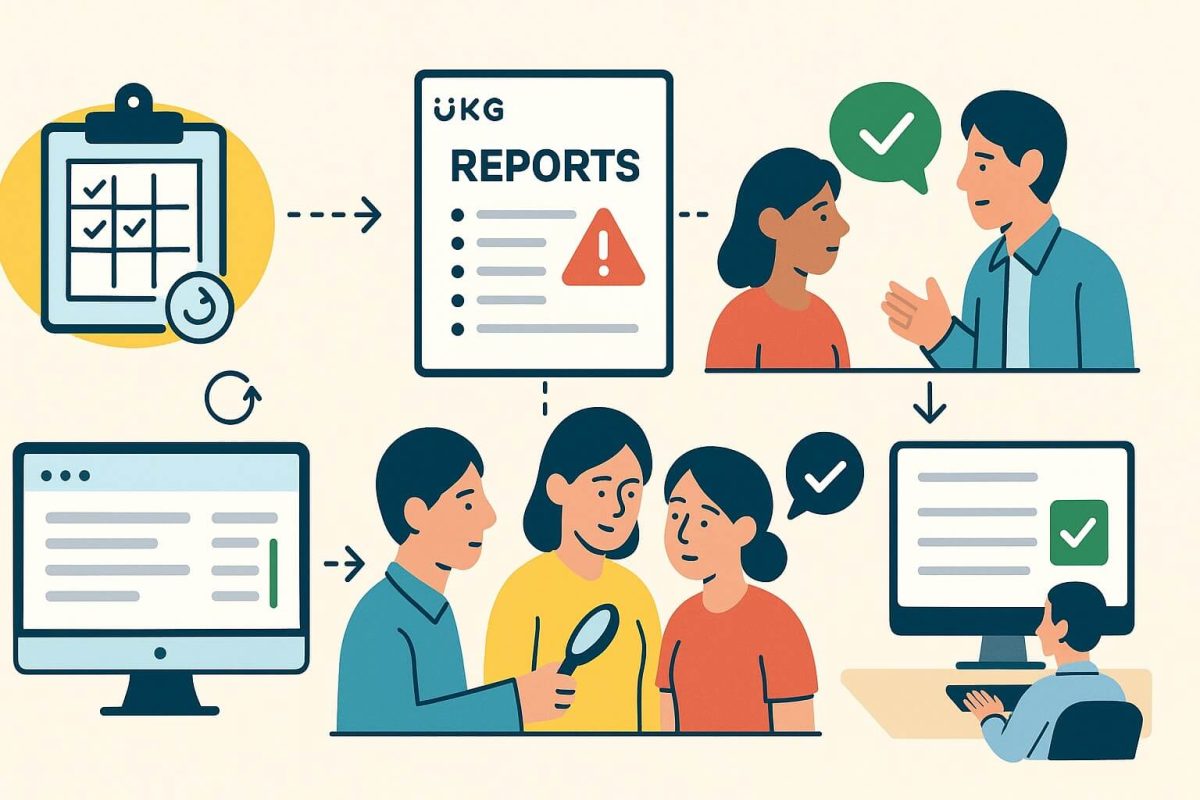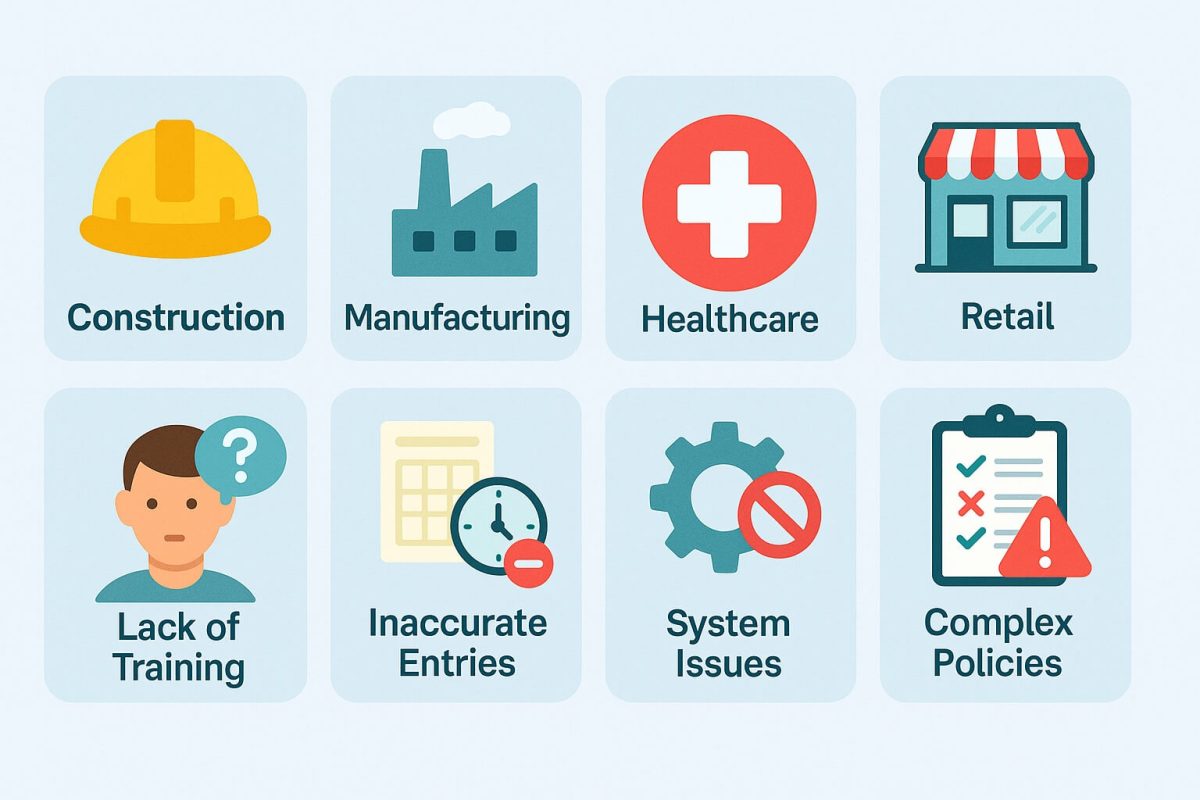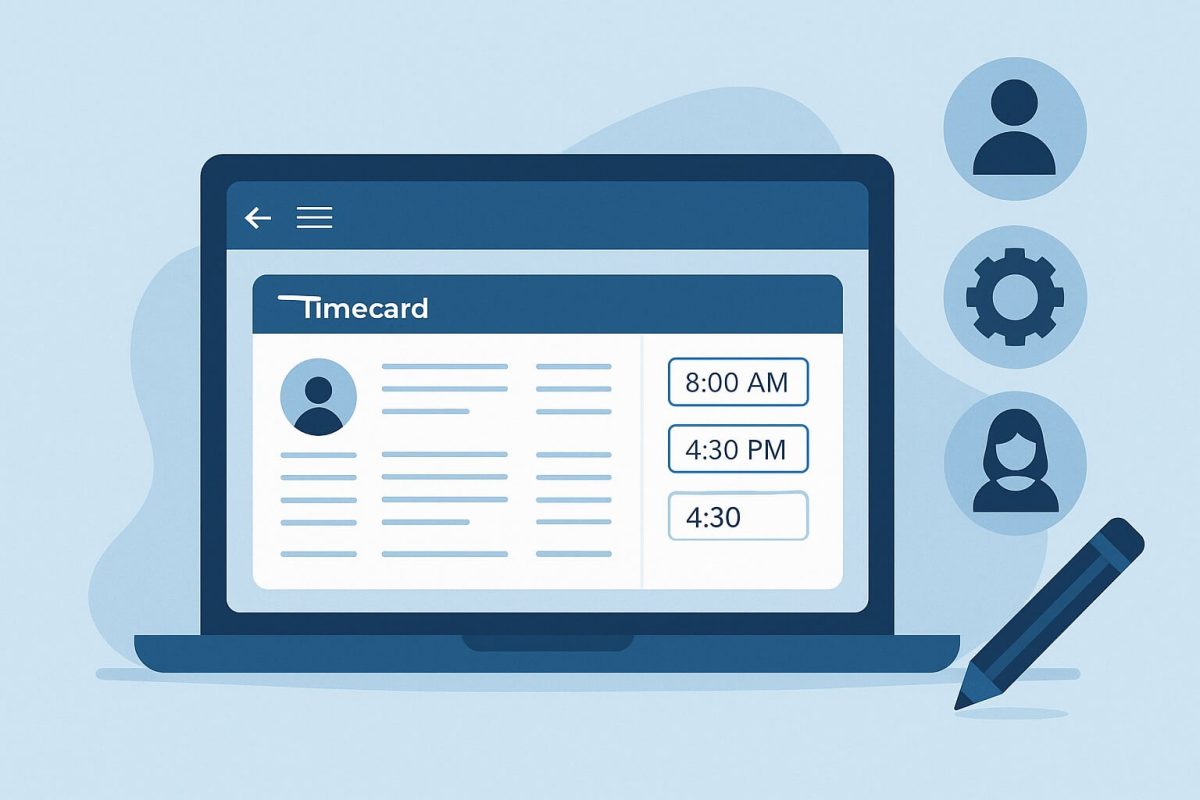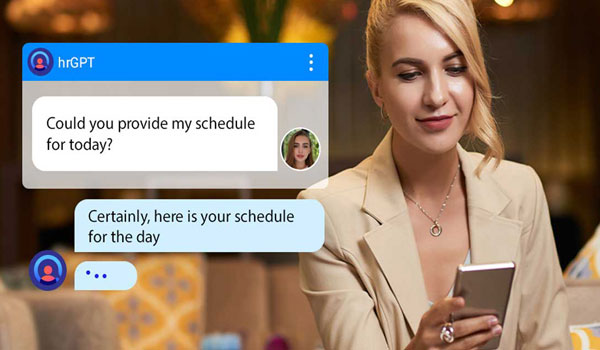Discover the intricacies of UKG time clock rounding and how CloudApper AI TimeClock surpasses on customer expectation. Tailor rounding with AI precision, ensuring workforce accuracy and seamless integration with leading HR systems. Experience a new era of timekeeping excellence.
Table of Contents
Key Takeaway
CloudApper AI TimeClock revolutionizes time clock rounding for UKG users, offering customizable and automated solutions tailored to diverse business needs. With advanced features like department-specific rounding and AI-driven insights, CloudApper enhances accuracy and efficiency in time tracking, simplifying workforce management and fostering operational excellence.
For more information on CloudApper AI TimeClock for UKG visit our page here.
Rounding is a crucial step in the complex world of timekeeping, particularly for UKG time clock installations. When it comes to payroll, employee justice, and overall workforce management, the effective use of time clock rounding can make a big difference. Examining typical situations and the elements that impact this critical component, this article dives into the details of how time clock rounding works in UKG. In addition, we highlight customized Kronos Time Clock‘s exceptional features, demonstrating how it can tailor and automate rounding to specific business needs.
Understanding UKG Time Clock Rounding: Common Scenarios
1. Rounding to the Nearest Quarter Hour:
- Default Setting: The majority of UKG time clock installations use this default value.
- Mechanics:
- If you time yourself within seven and a half minutes of a quarter-hour interval, you will be rounded to the nearest quarter-hour.
- If you start to clock in between seven and fifteen minutes before the end of a quarter hour, it will be rounded down to the previous quarter hour.
- Objective: Ensures accurate payroll by maintaining a reasonable balance between employees’ needs and the need for precise timekeeping.
2. Rounding to the Nearest Minute:
- Precision Focus: Particularly important for sectors that rely on precise timekeeping, some companies choose to round up to the closest minute.
- Mechanics: The time is rounded to the nearest whole minute if it is not exactly in the exact minute.
3. Rounding by Employee Type or Project:
- Flexibility Feature: Depending on the type of employee or the project, UKG permits customisation.
- Example: For hourly workers, it’s to the quarter of an hour, and for salaried workers, it’s to the nearest minute.
- Adaptability: Adapted rounding rules for each project to meet their individual requirements.
Factors Influencing Rounding
1. Grace Period Settings:
- Consideration: A waiting time before and after planned shifts is a common practice in many companies.
- Configuration: One option is to use the same rounding criteria for the entire workday, while another is to use non-rounded values for the grace time.
2. Overtime Calculations:
- Policy Variations: Overtime computations can differ in rounding nuances depending on pay policies.
- Example: Fair compensation for employees is ensured by certain organizations by rounding up all hours after a specific threshold.
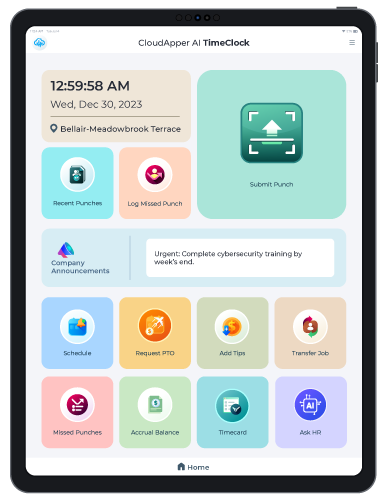
Enter CloudApper AI TimeClock: A Revolutionary Rounding Solution
CloudApper AI TimeClock offers customizable rounding setups with its superior control, accuracy, and automation capabilities.
1. Customizable Rounding:
- Tailored Configurations: With CloudApper AI TimeClock, businesses can tailor rounding to their exact specifications, meeting all of their special needs.
- Adaptable: The versatility of CloudApper AI TimeClock allows for minute-level precision or project-specific rounding.
2. Automated Precision:
- Efficiency Boost: The rounding process is made easier and more accurate with CloudApper AI TimeClock’s AI-driven precision, which eliminates the need for manual interventions.
- Consistent Accuracy: Rounding that is both consistent and accurate fosters an environment where employees trust and are open with one another.
3. Compatibility with Leading HR Systems:
- Seamless Integration: Workday, Oracle HCM, Kronos, UKG, ADP, and CloudApper AI TimeClock are just a few of the many popular HR systems that CloudApper AI TimeClock is compatible with.
- Uniform Experience: To guarantee a consistent and efficient rounding process, organizations can use varied HCM solutions.
AI-Driven Rounding Strategies for UKG
CloudApper AI TimeClock goes above and beyond in terms of advanced rounding features for UKG users. Here’s some example of rounding cases:
Scenario 1: Customizable Rounding by Job Code or Department
- With CloudApper, you can set up distinct rounding rules for each department or work code, giving you fine-grained control. Workers on the assembly line might be paid to the nearest minute, while administrative employees would be paid to the nearest quarter hour. Your organization’s needs can be met by embracing this flexibility.
Scenario 2: Automated Overtime Rounding Based on Predefined Rules
- According to employee contracts and predetermined thresholds, CloudApper can automatically round overtime to the closest fifteen minutes or twenty-five minutes. This gets rid of the need to manually calculate overtime pay and makes sure that employees don’t be overpaid for little time beyond their usual shift.
Scenario 3: Rounding Based on Pre-Approved Time Off or Sick Leave
- To ensure accurate tracking of leave and payroll deductions, CloudApper can automatically round an employee’s clock-in within a defined buffer period (e.g., 15 minutes) prior to the start of their scheduled time off, specifically when their pre-approved time off or sick leave exceeds the typical grace period.
Scenario 5: Rounding During Breaks with Activity Monitoring
- More accurate rounding during breaks is possible with CloudApper’s. To avoid possible inconsistencies in the calculation of break duration, employees can have their time rounded back to the end of the break if they begin working within a defined interval (e.g., 2 minutes) after returning from a break.
Scenario 6: Rounding Based on Geofencing for Remote Workers
- If an employee enters the designated work site within a predefined grace period, CloudApper can use geofencing to automatically round up their clock-in to the start of their shift, regardless of whether they physically arrive before the start of their shift. This guarantees that remote employees’ time is accurately recorded.
Scenario 7: Dynamic Rounding Based on Peak Hours
- Dynamic rounding rules can be implemented by CloudApper for firms whose activity levels fluctuate. It is possible to round to the next quarter-hour or minute during peak hours, but to the nearest fifteen minutes during off-peak hours, which is more liberal. The result is a happy medium between operational efficiency and employee flexibility.
Scenario 8: Automated Rounding to Match Project Requirements
- If your company’s projects have varied requirements for tracking time, CloudApper can adapt its rounding rules to each project’s individual requirements as employees clock in. Timekeeping for complex project-based environments is made easier with this.
Scenario 9: Predictive Rounding Based on AI Insights
- In order to foresee such rounding inconsistencies, CloudApper’s AI can examine past data and employee trends. After that, it can proactively recommend changes to the rounding rules to make sure they’re accurate and prevent problems in the future.
Scenario 10: Predictive Rounding Based on AI Insights
- Custom Rounding Preferences for Workers: With CloudApper, workers can choose their own rounding method, within the parameters provided by corporate policy. This allows them to feel more independent and in charge of their personal timekeeping while still following the rules as a whole.
These examples illustrate how CloudApper AI TimeClock enhances the efficiency of workforce management by going beyond simple rounding features and providing a flexible and intelligent approach to time tracking through the use of AI and customization options.
Conclusion: Elevate Precision, Simplify Workforce Management with CloudApper AI TimeClock
Rounded off time clocks are an absolute must in the ever-changing world of workforce management. Timekeeping has never been more efficient than with CloudApper AI TimeClock, thanks to its adjustable rounding, automated precision, and connectivity with top HR systems. An effective choice for enterprises that want to conquer time clock rounding is CloudApper AI TimeClock. It simplifies workforce management, ushers in a new era of accuracy, and elevates precision.





